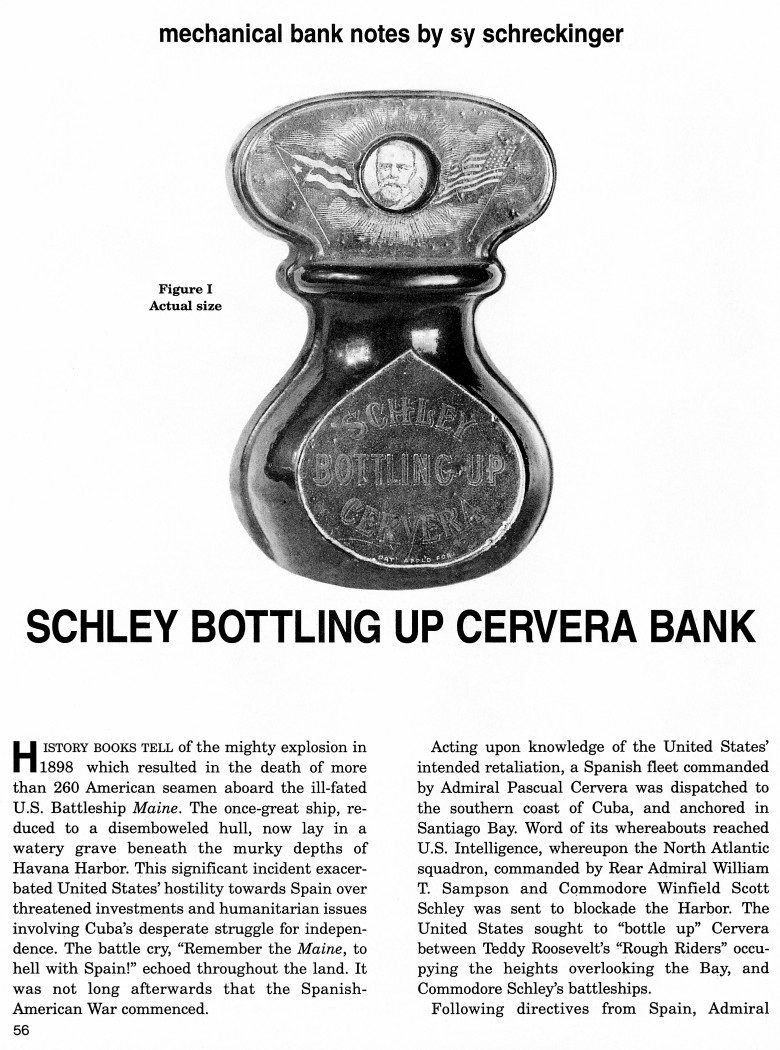|
Schley Bottling Up
Cervera Bank
by Sy Schreckinger – ANTIQUE TOY WORLD Magazine – May, 1996
History books tell of the mighty explosion in 1898 which resulted
in the death of more than 260 American seamen aboard the ill-fated U.S.
Battleship Maine. The once-great ship, reduced to a disemboweled hull, now
lay in a watery grave beneath the murky depths of Havana Harbor. This
significant incident exacerbated United States' hostility towards Spain
over threatened investments and humanitarian issues involving Cuba's
desperate struggle for independence. The battle cry, "Remember the Maine,
to hell with Spain!" echoed throughout the land. It was not long
afterwards that the Spanish-American War commenced.
Acting upon knowledge of the United States' intended retaliation, a
Spanish fleet commanded by Admiral Pascual Cervera was dispatched to the
southern coast of Cuba, and anchored in Santiago Bay. Word of its
whereabouts reached U.S. Intelligence, whereupon the North Atlantic
squadron, commanded by Rear Admiral William T. Sampson and Commodore
Winfield Scott Schley was sent to blockade the Harbor. The United States
sought to "bottle up" Cervera between Teddy Roosevelt's "Rough Riders"
occupying the heights overlooking the Bay, and Commodore Schley's
battleships.
Following directives from Spain, Admiral Cervera attempted to escape
by leading his fleet out of the Harbor. Ultimately, the ensuing battle
terminated with the destruction of Cervera's ships. For all practical
purposes, the war was now ended. A short time afterwards, Spain and the
United States met in Washington to negotiate an armistice and a protocol
was signed on August 12, 1898.
It was at approximately this time that two mechanical banks were
designed and manufactured, each depicting and immortalizing the conflict
between the two nations. One was entitled, "The U.S. and Spain Bank"
(refer to Antique Toy World,
February 1994), and the other, "The Schley
Bottling Up Cervera Bank" (Figure I), the subject of this article.
With less than a handful of known examples, the Schley and Cervera
bank remains one of the notable conundrums of mechanical bank collecting.
Not only is there a lack of information pertaining to the bank's designer,
but close examination of the piece itself offers no clues to its
manufacturer.
Design and operation of the Schley and Cervera bank is uncomplicated.
Shaped as a glass bottle, it is jarred to the left, causing a
black-and-white lithographed paper image of Admiral Cervera to appear in
the round window (see Figure I). Upon insertion of a coin, the image of
Cervera seemingly drops into the bank and is replaced by the image of
Commodore Schley, leaving Cervera literally "bottled up." Deposits are
removed by unscrewing both halves of the bank.
I am not aware of the existence of casting and/or color variants of
the Schley and Cervera bank. Colors of the mechanical illustrated in
Figure I are as follows: the entire surface is painted an overall glossy
black. The tear-shaped paper label is black with a gold border. The words,
"Schley Bottling Up Cervera" are red with a thin gold drop-shadow. Both
the American and Cuban flags are appropriately painted red, white and
blue. Finally, the sunburst effect around the pictures of the two
adversaries is gold, as is the thin line delineating the stopper-shaped
top of the bank.
Although, to date, no reproductions have surfaced, in view of the
extreme rarity of "Schley Bottling Up Cervera Bank," its recreation is not
inconceivable. Figure II is a contour diagram of an original example. A
recast, using an original example as a pattern, will appear approximately
one eighth to one quarter of an inch shorter along the vertical dimension
than indicated.
In conclusion, the Schley and Cervera bank had been manufactured
almost entirely of cast iron, the exception being the paper images of
Schley and Cervera and the tear-shaped label on the front.
|


